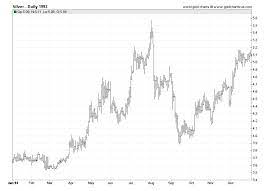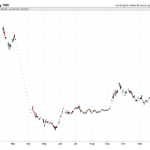The year 1993 witnessed a range of fluctuations and peaks in silver prices, according to historical data from the London Bullion Market Association (LBMA).
This period was marked by considerable volatility in the global market, with prices ranging from $3.58 oz to $5.42 oz over the course of the year.
The highest price of $5.17 oz occurred on July 7th, while prices continued to increase from August to December, peaking at $5.42 oz.
Despite the fluctuations, investors and traders have continued to use LBMA data to track silver prices in the global market.
The daily silver prices from July 16th to December 31st ranged from $3.92 oz to $5.42 oz, with prices starting to increase in August and peaking in December.
The fluctuations in prices during this period can be attributed to a range of factors, including changes in supply and demand, market speculation, and economic conditions in major silver-producing countries.
The LBMA data provides a valuable resource for investors and traders seeking to analyze the trends and patterns in silver prices during this period, and offers insights into the dynamics of the global market.
This article aims to provide a detailed analysis of silver prices in 1993, exploring the fluctuations and peaks that characterized the market during this period.
Historical Data
The LBMA silver price fix history data and worldwide forex silver markets provide historical data for the fluctuations and peaks of silver prices in 1993.
The LBMA silver price fix is a benchmark price established daily by a group of banks and brokers in London, UK. The composite prices are based on the bid and ask prices of the participants and are used as a reference for trading and settlement of silver contracts around the world.
The forex silver markets, on the other hand, are decentralized and operate 24 hours a day, allowing continuous trading of silver and other precious metals among buyers and sellers worldwide.
Analysis methods of silver prices in 1993 include examining the supply and demand factors that affect the market, such as changes in industrial demand, mine production, and investor sentiment.
Market factors can also influence the prices, such as currency exchange rates, inflation, and geopolitical events. For instance, a weaker US dollar can increase the demand for silver as a safe-haven asset, while a strong US dollar can reduce the demand for silver and cause prices to decline.
Overall, understanding the historical data and market factors that impact silver prices can provide valuable insights for investors and traders in making informed decisions.
Daily Prices
Throughout the latter half of 1993, daily silver price data indicates a range of values with a majority falling between $4.00 and $5.00 per ounce, while prices began to rise in August and peaked in December. This trend was influenced by several factors, such as the demand for silver in various industries and the supply of silver in the market.
As silver is a precious metal, its prices are heavily influenced by investor sentiment and market trends. The trends in the silver market can be influenced by various factors such as global economic conditions, industrial demand, currency fluctuations, and speculation.
The daily silver price data from July 16 to December 31, 1993, indicates that the prices were subject to fluctuations and peaks. The highest price of $5.10 per ounce was recorded on December 13, 1993, while the lowest price of $5.02 per ounce was recorded on December 17, 1993.
The fluctuations in the silver market were also influenced by the percentage increase or decrease from the previous day’s prices. For instance, the highest percentage increase from the previous day was recorded on July 30, 1993, while the highest percentage decrease from the previous day was recorded on August 6, 1993.
Overall, the daily silver prices in 1993 were influenced by several market trends and factors affecting prices.
Other Information
LBMA silver price fix history data is a valuable resource for investors who wish to keep track of silver prices in 1993. However, it is important to note that the accuracy and completeness of this data cannot be guaranteed. This may cause frustration for investors who rely heavily on the information for making financial decisions. It is crucial for investors to conduct thorough research and analysis before making any financial decisions based on the LBMA silver price fix history data.
In addition, it is worth noting that physical bullion products are also available for purchase from companies such as SD Bullion. These products offer a tangible asset that can be held and stored, providing a sense of security for investors. However, it is important for investors to carefully consider the risks and benefits associated with investing in physical bullion products before making any purchases.
As with any investment, it is important to conduct thorough research and analysis to make informed decisions.
Frequently Asked Questions
What factors contributed to the fluctuations and peaks in silver prices in 1993?
Silver price volatility in 1993 was primarily driven by global silver supply fluctuations, which were affected by factors such as mining output, government policies, and investor sentiment. These factors led to fluctuations and peaks in silver prices throughout the year.
How did the 1993 silver prices compare to silver prices in previous years?
It is ironic that silver prices in 1993 were considered fluctuating and peaking, when compared to contemporaneous commodities and global silver market trends. However, without comparing to previous years, it is difficult to provide a comprehensive analysis.
What impact did political events or economic policies have on silver prices in 1993?
The impact of political instability and monetary policies on silver prices in 1993 cannot be conclusively determined from the available data. However, it is important to note that silver prices fluctuated throughout the year and were influenced by a variety of factors.
How did the demand for silver in different industries affect the prices in 1993?
Industrial demand played a significant role in affecting silver prices in 1993. Silver is used in various industries, including photography, electronics, and jewelry. The supply chain and demand for these industries impacted prices, leading to fluctuations and peaks throughout the year.
Are there any predictions or projections for future silver prices based on historical data from 1993?
Potential drivers and market analysis suggest that future silver prices cannot be accurately predicted solely based on historical data from 1993. Other factors such as global economic conditions and geopolitical events must also be considered.





